Saturday 3rd December, 2011, 6.45am; Pengimana Hotel, Kalianget, Madura
Total distance: 309.8km
On the morning of the 1st of December we woke at 3.30am. It was still pitch black outside, and conciousness kept smearing back into sleep as I lay in my bed trying to figure out the best way of sitting up and getting out of bed. Liv was already up, and eventually I joined her, and staggered around getting ready, dead ants still lying at our feet.
Our driver arrived a little before 4am, he worked for Hari, the friend that Andi had gotten us in touch with. We hopped in the jeep and drove away down the road to Banyuwangi, and then veered right towards the two towering volcanoes that rose out of the landscape.
The ride up there was rough and steep, and took about two hours. We had considered cycling up to see it until Andi had told us that the road out the other end was impassible, and we didn't have the time or the desire to cycle two days up a 2800m mountain only to turn back and come down the same way. We were dropped off 3km from the summit where we purchased our entry tickets, then the two of us began our hike up the path to the crater.
We had learnt that as well as being a tourist attraction, Ijan Crater was the place of work for many local people, who came up here to mine the sulphur that formed in the crater. We saw a few of the workers sitting down at the bottom of the path chatting, and we said hello as we passed. One of them, Saryiono, began walking up behind us. He spoke very limited English, but we figured out that he did indeed mine sulphur here, that he was on his way to work, but we couldn't find out what the sulphur was used for.
After a little under an hour the rich vegetation that had clogged the land leading up disappeared abruptly, and a strong smell of rotten eggs wafted up our noses. The land suddenly became cracked and a dusty grey colour, like ash, and the only signs of life other than the few miners and tourists wandering by were blackened roots of trees lying dead in the barren landscape. The sulphuric smell was almost unbearable, and we had to wrap clothes around our mouths to stop ourselves from gagging.
As we walked over the brow of the hill though we could see down into the crater, and lying at the bottom amongst this dry martian landscape was a huge bright green lake speckled with yellow. At the bottom also, and just to the left of the lake we could see huge white clouds of gas flowing out of the rock. We walked onwards, and noticed as we came to the edge of the lip that there were dozens of miners hauling baskets full of sulphur up a rocky path that led down to the gas vents at the bottom. We had bumped into a few on the way up, and I had tried lifting the baskets that they carried. These were made from a strip of tough bamboo that held two small baskets, so that they could be balanced on their backs. I'm not great at guessing weights, but having packed up bicycle panniers for airports with weight in mind I think I have something of an idea. I would say that the two baskets full of sulphur would have been about 30 kilos. It was like lifting a semi-loaded bicycle over your shoulder and hauling it out of a crater, and down the other side. It would have been horrendous, and seeing the people come past us with their load, you could tell a lot of them were struggling from the gasps and moans they let out.
We were going to leave it there and head back, but we noticed a few tourists were coming up out of the track that led right down inside the crater, and the fellow who had walked up with us seemed to suggest it would be fine, so we began our descent.
It was steep, and we had to be very quick and careful to make sure we didn't get in the way of the numerous miners who were hauling their loads up the track. As we descended the sheer horror of this workplace became apparent, as the billowing white cloud of sulphuric gas was blown towards us by a sudden breeze, and suddenly the air we were surrounded by was not fit to breath, we put our jumpers to our mouths again, but the air still felt choking. Off in the distance through the white out we heard throaty, wheezing coughs.
 This job has to rate as the worst either of us has ever seen. Having to get up very early and get to the summit of a volcano, then descend down into a sulphuric gas spewing crater, then get right up to the vents and break off large chunks of yellow sulphur, put it in your basket and carry this extremely heavy load – too heavy – out of the crater again and down the other side, all the while breathing in toxic fumes that will likely eventually do you in. They did this two times a day, and got paid about $8 (5 quid) a day for it. It does rather put working in a call centre into perspective.
This job has to rate as the worst either of us has ever seen. Having to get up very early and get to the summit of a volcano, then descend down into a sulphuric gas spewing crater, then get right up to the vents and break off large chunks of yellow sulphur, put it in your basket and carry this extremely heavy load – too heavy – out of the crater again and down the other side, all the while breathing in toxic fumes that will likely eventually do you in. They did this two times a day, and got paid about $8 (5 quid) a day for it. It does rather put working in a call centre into perspective.
When we reached the bottom the sulphuric clouds became too much and we decided that we were going to get out of there. We said farewell to Sarionyo and gave him some money for his trouble. Unfortunately he had other ideas, and demanded that we pay him 50'000INDR – more than half a days wage for him, and rather a lot of money. Rather foolishly I had just thought this guy was walking up with us on his way to work, when in fact, and rather obviously really, he was trying to make some money as a guide.
What he was asking was a lot, not by Western standards to be sure, but for the hour and a half he had walked with us he wanted more than half a days wage. The problem was we couldn't barter with him because besides the money we had given him, the lowest note we had was 50'000INDR, and he had no change.
Travelling thickens your skin, perhaps too much sometimes. When you first enter some countries in Asia you quickly learn that you have to barter people down in order to avoid getting ripped off. Otherwise you spend $15 on a room when everyone else is paying $3. Once you get into this habit of bartering hard for things, because you know people think of you as rich and ripe for the ripping off, it is hard to break it. In retrospect we both agreed we should have given him the 50'0000INDR and had done with it. He didn't exactly guide us – the path was clearly marked – and he certainly never said anything about offering us any service, or mentioned any cash – his English was so limited he probably couldn't if he'd wanted to. But we had let him walk up with us, and so we had unwittingly taken up his services. There's a fine line between not getting ripped off and taken advantage of, and being a tight git who's got the upper hand.
As it was though, we stood firm, gave him the 10'000INDR we had offered him in the first place, and walked out of the crater, and back down to the jeep at the bottom. In truth we don't think he was too hard done by; he made 10'000INDR – about an eighth of his daily pay, for walking up to work a bit slower than usual, but then again we spent more than 10'000INDR on biscuits and coffee when we got out of the crater and back down the other side. A fine line.
Riding back down the pot-holed track in the back of the jeep our thoughts turned once again to the menace that was Javanese traffic. We had arrived in Ketapang at night, and while the motorbikes and trucks had been a little boisterous they had not seemed so bad. But that was at night. What would it be like during the day? Once we were packed and off on our way we learnt pretty quickly that it wasn't all that bad after all. True, vehicles did drive much closer as they overtook, but only one came closer than a few inches for the whole time we have ridden. As we rode north out of Ketapang we realised that it wasn't going to be so bad after all. The road was well maintained and populated by a scattering of mopeds, and a regular stream of noisy trucks that kicked up dust as they went.
Following Mr Pumpy's lead, we had decided to head north to the port at Jangkalor and then catch a ferry north to Madura island, then to cycle across the north coast of Madura then hopping back in Jakarta via a new bridge that now connects the two islands, then heading south east to Mt Bromo – an active volcano that Olivia has visited before and highly recommends. Mr Pumpy rode up Bromo some 12 years ago when he charted the trip, and says that going downhill the other end is very very steep indeed. The kind of steep that wears out a set of brake pads and has you nearly falling over the front handlebars.
The ride north was pleasant though, and kept fears of tumbling down the sides of volcanoes well out of the way. Our only concern was getting to Jangkalor by 1pm the next day, and considering it was only 65km away – a distance we could cover in about 5 hours, it really was no worry at all.
Unfortunately the effects of a disrupted diet due to the stomach bug I had in Lovina meant that my energy levels were low, and as we cycled through a 20km stretch of National Park they crashed and I found it a real struggle to keep pedalling. We had also just ridden past the last township for 20km, since the whole stretch of road through the park was empty but for guard posts, and night was only an hour and a half away.
Total distance: 309.8km
On the morning of the 1st of December we woke at 3.30am. It was still pitch black outside, and conciousness kept smearing back into sleep as I lay in my bed trying to figure out the best way of sitting up and getting out of bed. Liv was already up, and eventually I joined her, and staggered around getting ready, dead ants still lying at our feet.
Our driver arrived a little before 4am, he worked for Hari, the friend that Andi had gotten us in touch with. We hopped in the jeep and drove away down the road to Banyuwangi, and then veered right towards the two towering volcanoes that rose out of the landscape.
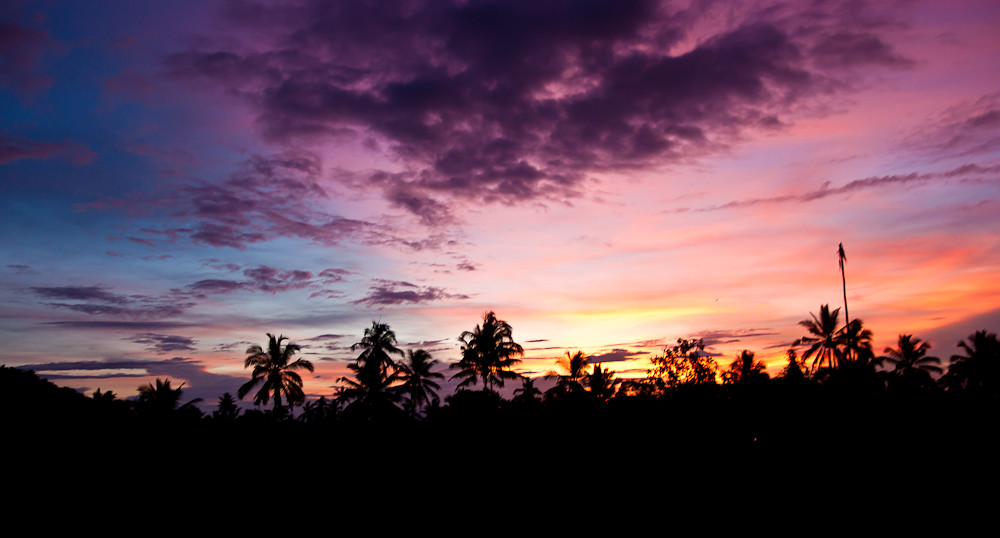 |
| Early morning views on the drive up to the crater |
 |
| Strange folds in the land near the summit |
After a little under an hour the rich vegetation that had clogged the land leading up disappeared abruptly, and a strong smell of rotten eggs wafted up our noses. The land suddenly became cracked and a dusty grey colour, like ash, and the only signs of life other than the few miners and tourists wandering by were blackened roots of trees lying dead in the barren landscape. The sulphuric smell was almost unbearable, and we had to wrap clothes around our mouths to stop ourselves from gagging.
 |
| The view down to the Ijen Crater. It stank of rotten eggs. Bleargh. |
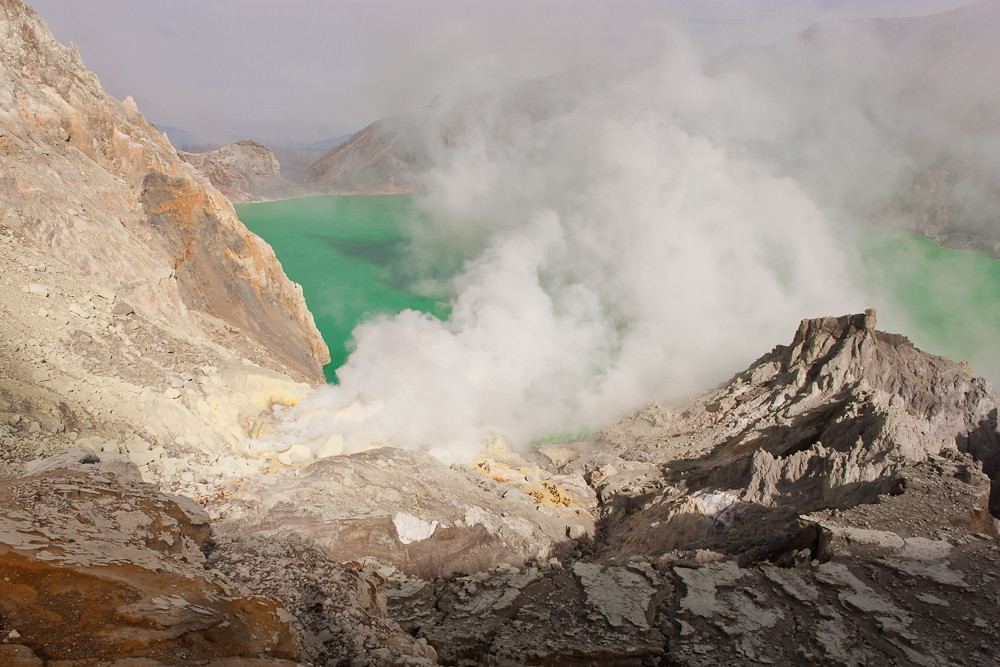 |
| Just at the bottom there, right in the fumes, are the miners. |
It was steep, and we had to be very quick and careful to make sure we didn't get in the way of the numerous miners who were hauling their loads up the track. As we descended the sheer horror of this workplace became apparent, as the billowing white cloud of sulphuric gas was blown towards us by a sudden breeze, and suddenly the air we were surrounded by was not fit to breath, we put our jumpers to our mouths again, but the air still felt choking. Off in the distance through the white out we heard throaty, wheezing coughs.
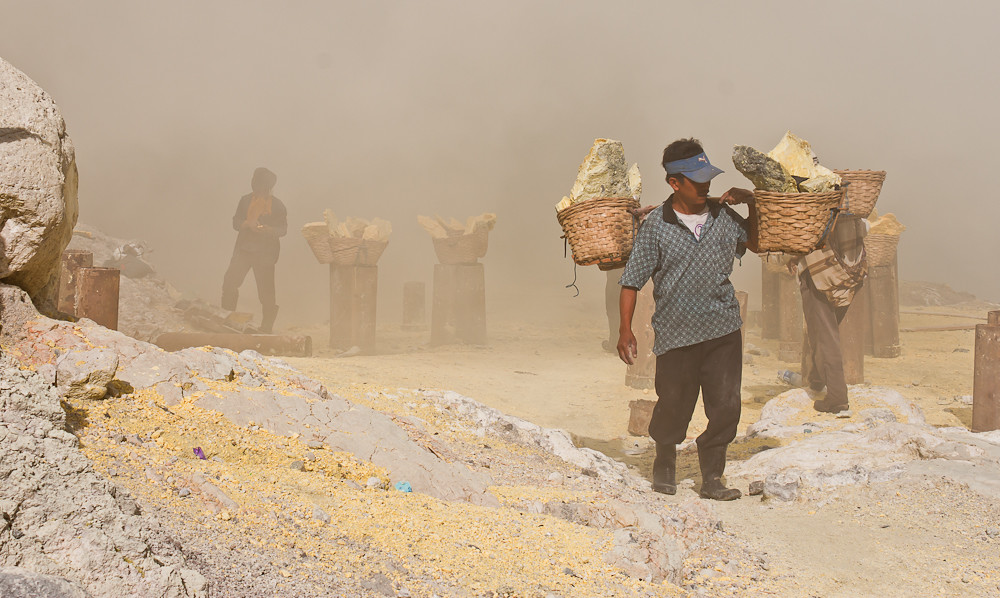 |
| The loads of sulphur are extremely heavy. 30kgs perhaps. And the smoke you can see all around is sulphuric gas. It is a grim place indeed. |
 This job has to rate as the worst either of us has ever seen. Having to get up very early and get to the summit of a volcano, then descend down into a sulphuric gas spewing crater, then get right up to the vents and break off large chunks of yellow sulphur, put it in your basket and carry this extremely heavy load – too heavy – out of the crater again and down the other side, all the while breathing in toxic fumes that will likely eventually do you in. They did this two times a day, and got paid about $8 (5 quid) a day for it. It does rather put working in a call centre into perspective.
This job has to rate as the worst either of us has ever seen. Having to get up very early and get to the summit of a volcano, then descend down into a sulphuric gas spewing crater, then get right up to the vents and break off large chunks of yellow sulphur, put it in your basket and carry this extremely heavy load – too heavy – out of the crater again and down the other side, all the while breathing in toxic fumes that will likely eventually do you in. They did this two times a day, and got paid about $8 (5 quid) a day for it. It does rather put working in a call centre into perspective.When we reached the bottom the sulphuric clouds became too much and we decided that we were going to get out of there. We said farewell to Sarionyo and gave him some money for his trouble. Unfortunately he had other ideas, and demanded that we pay him 50'000INDR – more than half a days wage for him, and rather a lot of money. Rather foolishly I had just thought this guy was walking up with us on his way to work, when in fact, and rather obviously really, he was trying to make some money as a guide.
What he was asking was a lot, not by Western standards to be sure, but for the hour and a half he had walked with us he wanted more than half a days wage. The problem was we couldn't barter with him because besides the money we had given him, the lowest note we had was 50'000INDR, and he had no change.
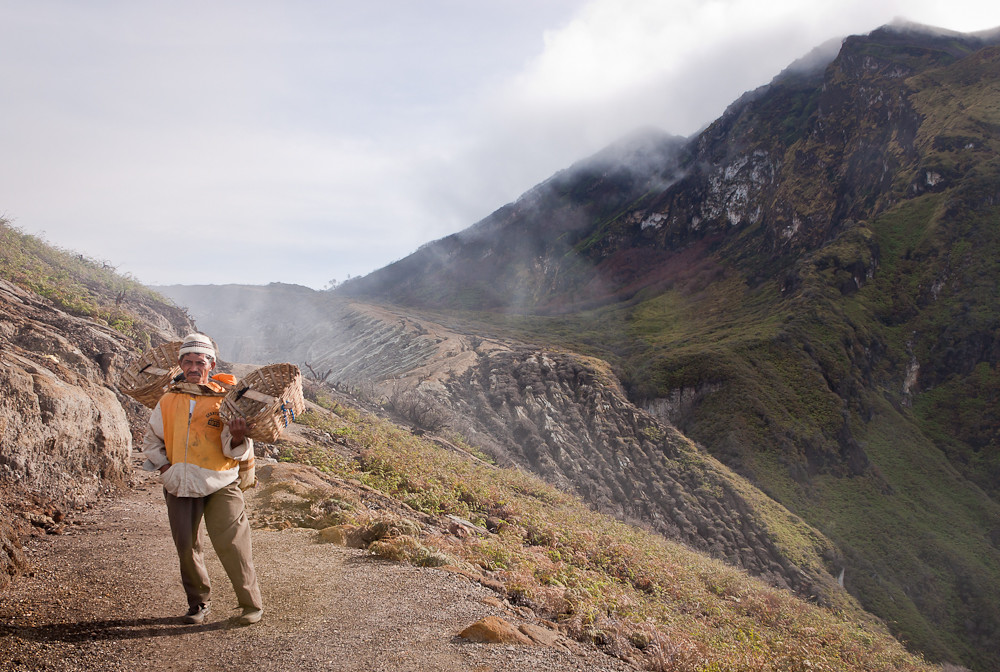 |
| Sariyano near the lip of the crater |
Travelling thickens your skin, perhaps too much sometimes. When you first enter some countries in Asia you quickly learn that you have to barter people down in order to avoid getting ripped off. Otherwise you spend $15 on a room when everyone else is paying $3. Once you get into this habit of bartering hard for things, because you know people think of you as rich and ripe for the ripping off, it is hard to break it. In retrospect we both agreed we should have given him the 50'0000INDR and had done with it. He didn't exactly guide us – the path was clearly marked – and he certainly never said anything about offering us any service, or mentioned any cash – his English was so limited he probably couldn't if he'd wanted to. But we had let him walk up with us, and so we had unwittingly taken up his services. There's a fine line between not getting ripped off and taken advantage of, and being a tight git who's got the upper hand.
As it was though, we stood firm, gave him the 10'000INDR we had offered him in the first place, and walked out of the crater, and back down to the jeep at the bottom. In truth we don't think he was too hard done by; he made 10'000INDR – about an eighth of his daily pay, for walking up to work a bit slower than usual, but then again we spent more than 10'000INDR on biscuits and coffee when we got out of the crater and back down the other side. A fine line.
Riding back down the pot-holed track in the back of the jeep our thoughts turned once again to the menace that was Javanese traffic. We had arrived in Ketapang at night, and while the motorbikes and trucks had been a little boisterous they had not seemed so bad. But that was at night. What would it be like during the day? Once we were packed and off on our way we learnt pretty quickly that it wasn't all that bad after all. True, vehicles did drive much closer as they overtook, but only one came closer than a few inches for the whole time we have ridden. As we rode north out of Ketapang we realised that it wasn't going to be so bad after all. The road was well maintained and populated by a scattering of mopeds, and a regular stream of noisy trucks that kicked up dust as they went.
Following Mr Pumpy's lead, we had decided to head north to the port at Jangkalor and then catch a ferry north to Madura island, then to cycle across the north coast of Madura then hopping back in Jakarta via a new bridge that now connects the two islands, then heading south east to Mt Bromo – an active volcano that Olivia has visited before and highly recommends. Mr Pumpy rode up Bromo some 12 years ago when he charted the trip, and says that going downhill the other end is very very steep indeed. The kind of steep that wears out a set of brake pads and has you nearly falling over the front handlebars.
The ride north was pleasant though, and kept fears of tumbling down the sides of volcanoes well out of the way. Our only concern was getting to Jangkalor by 1pm the next day, and considering it was only 65km away – a distance we could cover in about 5 hours, it really was no worry at all.
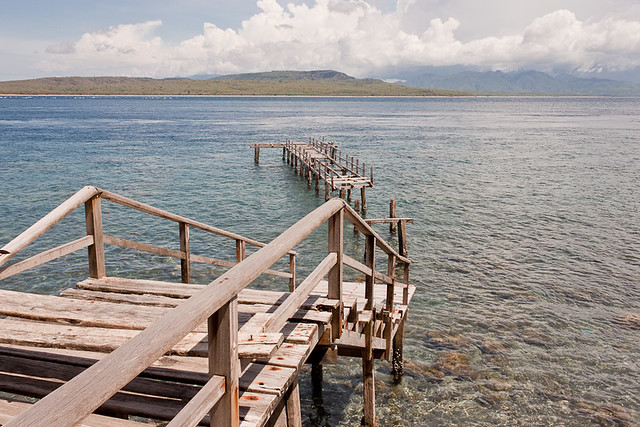 |
| The view over the strait to Bali at lunch time. |
Unfortunately the effects of a disrupted diet due to the stomach bug I had in Lovina meant that my energy levels were low, and as we cycled through a 20km stretch of National Park they crashed and I found it a real struggle to keep pedalling. We had also just ridden past the last township for 20km, since the whole stretch of road through the park was empty but for guard posts, and night was only an hour and a half away.
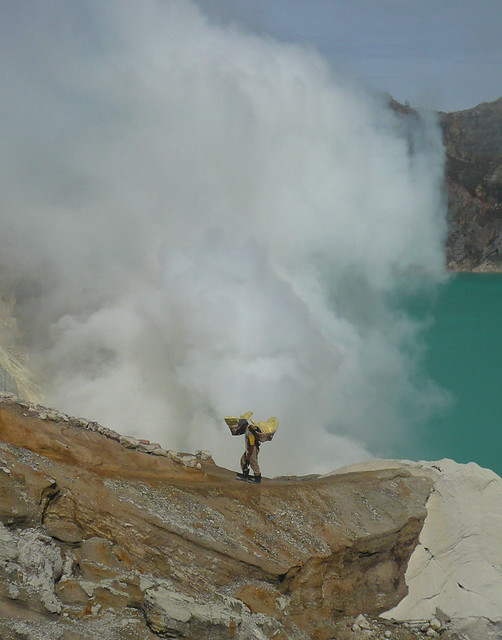
No comments:
Post a Comment